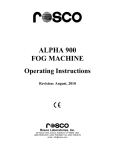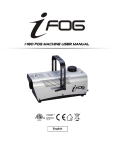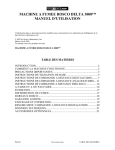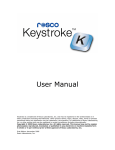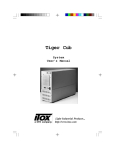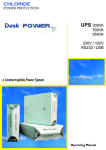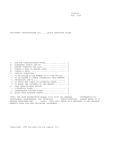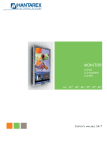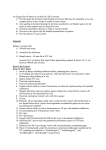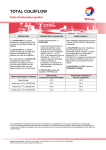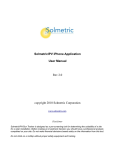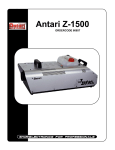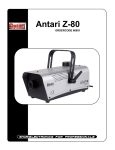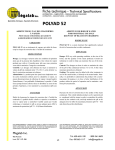Download Rosco Coldflow Operating Instructions
Transcript
Rosco Coldflow Operating Instructions November, 2008 Rosco Laboratories, Inc. 52 Harbor View Avenue, Stamford, CT 06902, USA (800) ROSCONY, (203) 708-8900, Fax: (203) 708-8919 email: [email protected] ROSCO COLDFLOW Operation Manual TABLE OF CONTENTS INTRODUCTION ......................................................................................................... ..…1 IMPORTANT SAFEGUARDS...........................................................................................2 HOW THE MACHINE WORKS........................................................................................3 OPERATING INSTRUCTIONS.........................................................................................4 DO'S AND DON'TS............................................................................................................6 MAINTENANCE................................................................................................................7 FOG DISTRIBUTION ........................................................................................................ 7 REPAIRS.............................................................................................................................8 RETURNS ...........................................................................................................................9 STORAGE AND SHIPMENT ............................................................................................9 LIMITED WARRANTY................................................................................................... 10 TECHNICAL SPECIFICATIONS....................................................................................11 INTRODUCTION The ROSCO COLDFLOW is an accessory for standard fog machines that converts liquid carbon dioxide (LCO2) to dry ice. The dry ice cools a uniquely designed aluminum extrusion that is capable of converting large volumes of fog into dense low lying fog, The unit can create a wide range of low lying fog effects from a continuous layer to a gigantic cloudburst. Best results will be achieved when the ROSCO COLDFLOW is used with any Rosco fog machine plus Rosco Stage & Studio Fog Fluid. COLDFLOW is a registered trademark of High End industries, Inc. Parts of this manual are the copywright of High End Systems, Inc. and are used with their permission. ROSCO COLDFLOW Page 1 www.rosco.com 11/08 IMPORTANT SAFEGUARDS READ AND UNDERSTAND THESE SAFETY PRECAUTIONS BEFORE OPERATING THE MACHINE. FAILURE TO PROPERLY FOLLOW THESE PRECAUTIONS MAY LEAD TO A FIRE, EXPLOSION, OR ELECTRICAL SHOCK. FOG FLUID HEALTH CAUTION: VAPOR FROM THIS FLUID, LIKE ANY OTHER COMMON MATERIAL IN A VAPORIZED STATE, MAY BE IRRITATING TO OR CAUSE ALLERGIC SYMPTOMS IN SOME PERSONS WITH ALLERGENIC SENSITIVITY. DO NOT EXPOSE AT CLOSE RANGE TO KNOWN ASTHMATICS. CARBON DIOXIDE HEALTH CAUTION: THIS MACHINE USES LIQUID CARBON DIOXIDE. IT MUST ALWAYS BE USED IN ADEQUATELY VENTILATED SPACES TO AVOID POSSIBLE ASPHYXIATION FROM HIGH CONCENTRATIONS OF CARBON DIOXIDE. DO NOT ALLOW ANYONE TO BE COMPLETELY ENVELOPED IN THE FOG. 1. This machine uses electrical power at common commercially available voltages. When directly contacted, such voltages are hazardous to human life. All precautions commonly applicable to the use of electric power generally are applicable to the use of this machine. This machine is designed to operate from three-wire power systems where one of the wires is a safety ground. DO NOT disconnect the safety ground or use extension cords or "cheater" plugs to connect this machine to a two-wire system. Operation without a safety ground may result in a hazardous electrical shock. 2. Check the current and voltage rating of your machine. Extension cords must be properly sized and rated for voltage, current and length. Check your local electrical code for the correct gauge extension cord. If an extension cord shows signs of wear or gets warm to the touch, discontinue its use and obtain a cord with a higher current rating. Improper extension cords are not only hazardous, but may result in poor machine performance due to excessive voltage drop. 3. Never use any machine that shows signs of improper use. Even slight damage may be an indication of a major problem. If the machine looks questionable, use it only under strict observation. If the machine shows any unusual behavior, disconnect machine immediately from power and send machine to a Service Center for repair. 4. The machine uses liquid CO2 (LCO2) under pressure. Be sure that all personnel operating the ROSCO COLDFLOW are completely familiar with safety procedures concerning the handling of LCO2. Please contact the supplier of the LCO2 for all pertinent safety information. 5. It is important that the proper type of LCO2 tank be used. See Specifications (p. 11) for information. 6. Make sure that all fittings and hoses are tight and in proper working condition. If any hose leaks or shows signs of wear, immediately turn off all pressure and disconnect the machine according to directions. ROSCO COLDFLOW Page 2 www.rosco.com 11/08 7. In any facility, the fog concentration should be controlled. The fog should never mask emergency exits, safety signs, staircases or other safety constructions. 8. Machines are designed for continuous use over an 8-hour day, but to protect components, it is wise to turn off the machine when it is not in use. In permanent installations, it is advisable to equip the circuit with a night cut-off device. 9. Parts of the machine can be very cold when used. Always handle the machine during and after use with gloves. 10. The fog should be blown into an open space and should not be directed at people or objects. Never blow fog on hot surfaces, into glowing heating elements or into open flames. The normally non-flammable and non-toxic haze could react on very hot surfaces and be burnt or decomposed. 11. Unauthorized repair or alteration of any safety devices can lead to improper operation and accidents. Repairs should be performed only by an authorized Service Center. WARNING: USE OF ANY FLUID OTHER THAN ROSCO FOG FLUID OR MODIFICATION OR ATTEMPTED UNAUTHORIZED REPAIR OF THE ROSCO COLDFLOW WILL IMMEDIATELY INVALIDATE THE WARRANTY. HOW THE MACHINE WORKS When the ROSCO COLDFLOW is enabled, a cryogenic solenoid valve opens, allowing liquid carbon dioxide (LCO2) to enter a containment chamber where it is converted to dry ice. When the containment chamber is fully charged, a thermal sensor turns off the valve. Once the chamber is cooled to a sufficiently low temperature, the fog machine may be turned on, passing the fog through the cooling tunnel where it is chilled. The chilled fog will lie low to the ground. ROSCO COLDFLOW Page 3 www.rosco.com 11/08 OPERATING INSTRUCTIONS 1. ATTACHING THE LIQUID CARBON DIOXIDE Attach the transfer hose from the ROSCO COLDFLOW to the liquid valve on the LCO2 tank using the 11/8 inch (29 mm) wrench provided with the unit. First install the nylon washer supplied with the unit in the tank/transfer hose connection to insure a positive seal, then connect the CGA transfer hose nut to the CGA LCO2 Port on the tank and tighten it securely; the liquid valve on the tank should be clearly marked. Slowly turn on the LCO2 valve, allowing the transfer hose to pressurize NOTE: It is important that you obtain the proper type of LCO2 tank for safe operation of the ROSCO COLDFLOW. LCO2 tanks are available from many welding supply dealers and other dealers who supply common inert gasses. Please give the following specifications to your LCO2 supplier when placing an order for the delivery of an LCO2 tank. For assistance, contact your Rosco dealer or distributor. Tank Types and Pressures 50 lb. CO2 tank (commonly referred to as a Siphon Cylinder or Dip Tube) Maximum Operating Pressure: 1000 psig (69 BAR) b) Portable Cryogenic VGL Cylinder (commonly referred to as a Dewar) Maximum Operating Pressure: 435 psig (30 BAR) Minimum Operating Pressure: 290 psig (20 BAR) CGA 320 fittings (U.S.A. Standard) Note: Clearly mark the liquid valve port on the LCO2 tank. 2. ENABLE THE MACHINE Plug the power cord into a socket rated at the proper voltage and amperage. Plug the remote control into the back of the machine. Press the ENABLE button on the remote control. This starts the unit's internal timer and begins the cooling process. The green ENABLE light on the remote control unit will light. This light remains on until you press the ENABLE button again to disable the control electronics. The amber COOLING light on the remote control will be on. When you are using the 7 ft (2.1 meter) transfer hose supplied with the unit, allow the ROSCO COLDFLOW to charge for approximately five minutes before use to ensure optimum performance. The unit's built in timer-override allows the LCO, cooling chamber to charge for approximately five to fifteen minutes, depending upon the length of the transfer hose. During this charging period, the amber COOLING light on the remote control is on. Once the unit reaches its regulated temperature, it continues to charge for five minutes. When the unit is fully charged, the green READY light on the remote control will light. ROSCO COLDFLOW Page 4 www.rosco.com 11/08 3. MAKING LOW-LYING FOG Place the outlet of the fog machine 3 - 5 inches (8 cm - 13 cm) from the inlet opening of the ROSCO COLDFLOW, directing the fog into the cooling tunnel of the unit. Turn on the fog machine and allow it to warm up. When the fog machine is ready, turn on the fog. Adjust the amount of fog passing through the ROSCO COLDFLOW to create the desired low lying fog effect. NOTE: Carefully follow all instructions in the manual accompanying the fog machine. Use Rosco Stage & Studio Fog Fluid for optimum results. 4. SHUTTING DOWN THE SYSTEM Press the ENABLE button on the remote control to disengage the unit. This stops the flow of LCO2. NOTE: It is not necessary to disconnect the LCO2 tank when using the unit in a permanent installation. 5. DISCONNECTING THE SYSTEM WARNING: WEAR SAFETY GLASSES AND GLOVES DURING THE DISCONNECTION PROCEDURE TO PROTECT YOURSELF FROM CONTACT WITH LOW SURFACE TEMPERATURES AND ANY ESCAPING CO2. Turn the valve on the LCO2 tank to the closed position. Then, using the fitting wrench supplied with the ROSCO COLDFLOW, disconnect the transfer hose from the LCO2 tank. First, loosen the fitting allowing the LCO2 transfer line to depressurize slowly before completing the disconnection. If the unit is used for a prolonged period, you may need to drain it before moving. To remove any unevaporated water from the unit, insert the drain tube, included with the ROSCO COLDFLOW, into the quick disconnect located at the rear of the machine and transfer the condensation to an appropriate container. NOTE: It may be necessary to tilt the unit slightly to help the water drain completely. Caution: The Flow Inlet/Outlet grill areas may be very cold. Handle with caution. 6. USING THE MACHINE FREE FROM TANK (OPTIONAL) Follow the instructions in Steps 1 and 2 above. Disconnect the unit from the LCO2 tank as described in Step 5. CAUTION: Follow all cautions when disconnecting the transfer hose from the LCO2 tank. Transport the unit to the remote location where it will be used. Set up and engage the fog machine as described in Step 3 of this section. NOTE: After disconnecting from the LCO2 tank, the unit will remain cold enough to use for approximately 30-60 minutes, depending on conditions. ROSCO COLDFLOW Page 5 www.rosco.com 11/08 DO'S & DON'TS DO Read the entire manual before operating the machine and pay particular attention to all CAUTIONS AND WARNINGS. DO Use an extension cord which is properly rated for voltage, current and length and which is free from nicks or other signs of wear. DO Use a hose which is free from nicks or other signs of wear. DO Before each operating period, check to see that the machine is clean and free of foreign objects. DO Ensure that the machine is adequately ventilated. DO Use proper caution when handling cold surfaces DO Use the minimum amount of fog required to achieve the desired effect. DO NOT Use the machine near a person who has asthma or similar inhalation disorder. DO NOT Use any foreign substances in the machine. DO NOT Use a machine that is damaged or operating improperly in any way. DO NOT Use a machine that leaks fluid from the housing. DO NOT Enclose the machine. DO NOT Install the machine in such a fashion that the operator cannot see the whole machine including indicator lights. DO NOT Direct the fog continuously against the same spot. This may eventually cause fog fluid to recondense on walls, furniture, sets, etc. READ THE COMPLETE MANUAL TO INSURE SAFE OPERATION. ROSCO COLDFLOW Page 6 www.rosco.com 11/08 MAINTENANCE 1. The ROSCO COLDFLOW has two fuses, both located on the main control board located inside the machine. NOTE: Be sure to check the specifications when replacing any fuses. WARNING: DISCONNECT THE ROSCO COLDFLOW FROM POWER BEFORE CHECKING OR REPLACING THE FUSE. FAILURE TO DO SO COULD BE HAZARDOUS AND RESULT IN AN ELECTRICAL SHOCK. 2. After every operation the machine should be wiped with a clean damp cloth or paper towel. This practice prevents the build up of dirt and dust which may enter the machine and damage sensitive internal components. 3. During use, operation of all switches and indicator lights should be monitored. Lights that blink or flicker when they should be on or off, for example, are an indication of problems in the machine's circuitry. FOG DISTRIBUTION The fog distribution in an enclosed area depends on air flow and temperature. Natural air movement, air conditioning and other ventilation systems will affect movement of fog. Test under realistic conditions before using. The ROSCO COLDFLOW works properly only in a horizontal position. Do not tilt the machine during operation. For assistance in dealing with unusual fog requirements, consult a distributor or a Rosco office. To achieve colored fog use spotlights and Rosco color filters. Do not add colorants to fluid. ROSCO COLDFLOW Page 7 www.rosco.com 11/08 REPAIRS If the machine fails and repairs are required, call or write the nearest Rosco office (listed below) for the name of a Rosco Repair Center near you. UNITED STATES World Headquarters Rosco Laboratories, Inc. 52 Harbor View Avenue Stamford, CT 06902 +1 (203) 708-8900 (800) 767-2669 E-mail: [email protected] Rosco Laboratories, Inc. 1265 Los Angeles Street Glendale, CA 91204 +1 (818) 543-6700 (800) 767-2652 Rosco Service Center 1675 Brandywine Ave. Suite B San Diego, CA 91911 +1 (619) 423-1985 (800) 468-0114 CANADA Rosco Laboratories, Ltd. 1241 Denison Street, #44 Markham, Ontario L3R 4B4 (905) 475-1400 (888) ROSCO TO E-mail: [email protected] ROSCO COLDFLOW UNITED KINGDOM Roscolab, Ltd. Blanchard Works Kangley Bridge Road Sydenham, London SE26 5AQ England +44 (0)208 659 2300 E-mail: [email protected] SPAIN & PORTUGAL Rosco Iberica, S.A. C/Oro,76 Polígono Industrial Sur 28770 Colmenar Viejo, Madrid. España (34) 918 473 900 E-mail: [email protected] AUSTRALIA Rosco Australia Pty Ltd. 42 Sawyer Lane Artarmon 2064 N.S.W. Australia (02) 9906-6262 E-mail: [email protected] BRAZIL Rosco do Brasil Ltda. R. Antônio de Barros, 82 03401-000 São Paulo-SP +55 (11)6198 2865 E-mail: [email protected] Page 8 www.rosco.com 11/08 RETURNS 1. Call the nearest Rosco office for shipping instructions. 2. Pack carefully and ship (in the U.S.) via UPS or parcel post prepaid. Insurance is suggested. 3. Attach a letter to the top of the machine explaining the problem in detail. 4. Enclose a copy of Rosco invoice or other proof of purchase. 5. If the machine is out of warranty, an estimate of repair cost will be provided on request. Otherwise, repairs will be accomplished and billed. 6. When ready, the machine will be returned (in the U.S.) via UPS. STORAGE AND SHIPMENT If you do not anticipate using your machine for an extended period, prepare your machine for storage as follows: 1. Perform maintenance as outlined in "Maintenance" section. 2. Wipe the outside of the machine clean. 3. Store in a sealed cardboard box. 4. Whenever the unit is shipped, considerable care should be taken in packing to avoid damage in transit. ROSCO COLDFLOW Page 9 www.rosco.com 11/08 LIMITED WARRANTY Rosco Laboratories, Inc. warrants to the original purchaser that the ROSCO COLDFLOW will be free from original defects in workmanship and material for a period of six months from the date of purchase. During the warranty period, machines will be repaired or replaced at the option of Rosco. If the purchaser returns a completed registration card to Rosco within 30 days of purchase, Rosco will extend the limited warranty to a FULL YEAR from the date of purchase. If the warranty card is not received by Rosco, the warranty will remain effective for six months. The warranty does not extend to any parts of the ROSCO COLDFLOW that have been subject to misuse or accident. Neither does the warranty cover any Rosco machine that has been opened, modified or repaired other than by Rosco or its designated repair station. The warranty will not apply if procedures described in the Instruction Manual are not followed. It is the user's obligation to clean and maintain the ROSCO COLDFLOW according to these instructions, and to follow acceptable practices for handling electrical devices. NOTE: USE OF ANY FLUID OTHER THAN A ROSCO BRAND FOG FLUID WILL VOID WARRANTY. ROSCO COLDFLOW Page 10 www.rosco.com 11/08 ROSCO COLDFLOW TECHNICAL SPECIFICATIONS POWER REQUIREMENTS 100/120 volts, 50/60 Hz, 0.5 amps 200/240 volts, 50/60 Hz, 0.25 amps DIMENSIONS 22 in x 12.5 in x 12in 56 cm x 32 cm x 31 cm WEIGHT 40 lb., 18 kg FUSE TYPE 120 volt-250 volt/1 amp (5mm x 20mm) 240 volt-250 volt/0.5 amp (5mm x 20mm) TANK TYPES AND PRESSURES a) 50 lb. CO2 tank Maximum Operating Pressure: 1000 psig (69 BAR) b) Portable Cryogenic VGL Cylinder Maximum Operating Pressure: 435 psig (30 BAR) Minimum Operating Pressure: 290 psig (20 BAR) CGA 320 fittings (U.S.A. Standard) Note: Clearly mark the liquid valve port on the LCO2 tank. ROSCO COLDFLOW Page 11 www.rosco.com 11/08












